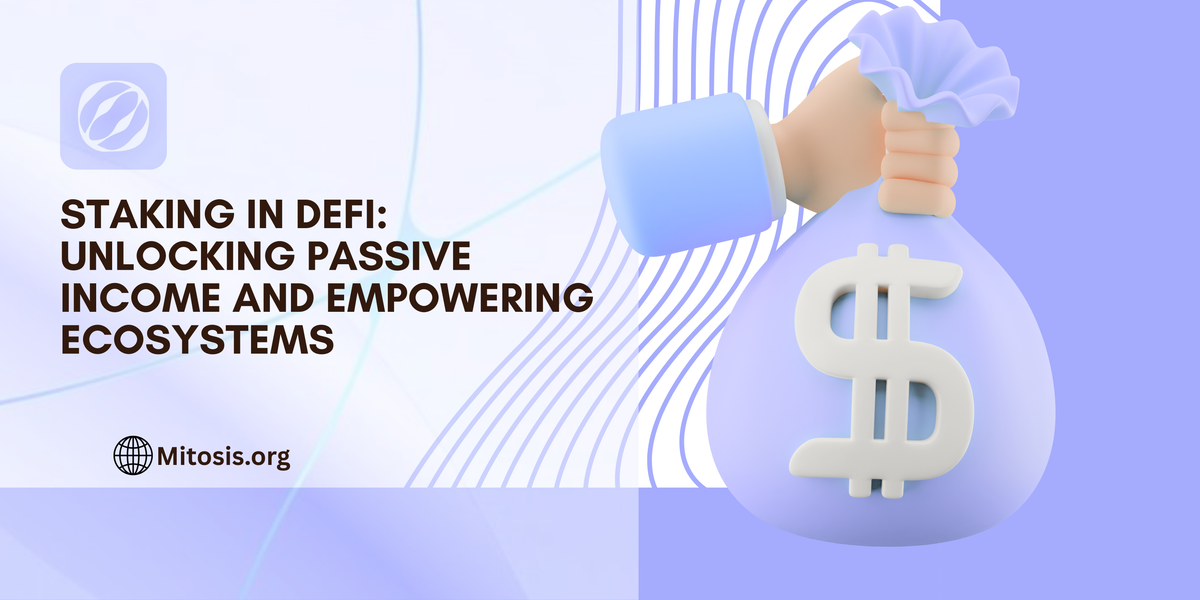Staking in DeFi: Unlocking Passive Income and Empowering Ecosystems

Staking has become a foundational component of decentralized finance (DeFi), enabling users to earn passive income by locking their cryptocurrency assets to support network operations. In proof-of-stake (PoS) blockchains, validators are selected based on the amount of cryptocurrency they stake, contributing to network security and consensus. This mechanism not only incentivizes participation but also promotes decentralization and energy efficiency compared to traditional proof-of-work systems. See Mitosis University
For a comprehensive overview of staking, including its benefits and risks, readers can refer to Mitosis University, which provides educational resources on staking and its role in DeFi ecosystems.
The Mechanics of Staking: How It Works
At its core, staking involves committing a certain amount of cryptocurrency to a blockchain network, either by running a validator node or delegating to one. Participants earn rewards proportional to their stake, often in the form of additional tokens. This process not only secures the network but also aligns the interests of participants with the health and success of the blockchain.
Mitosis enhances this model by introducing programmable liquidity through its Matrix product. Users can deposit assets into Mitosis vaults and receive derivative tokens like miAssets and maAssets, which represent their staked positions and can be utilized across various DeFi applications within the Mitosis ecosystem. See MitosisMitosis Docs | Mitosis Docs
Benefits of Staking: Beyond Passive Income
While the prospect of earning passive income is a significant draw, staking offers a multitude of benefits that extend beyond financial gains. By participating in staking, users contribute to the decentralization and security of blockchain networks, fostering a more robust and resilient ecosystem. Additionally, staking can provide participants with governance rights, allowing them to have a say in the future development and direction of the network. See https://mirror.xyz/t0xci.eth/wbnWVTQVzFA8LC37UWStUN9vbCLVgKY6YbkxJpXS2Go
Mitosis exemplifies this by granting governance rights to holders of miAssets, enabling them to participate in decision-making processes regarding liquidity allocation and protocol upgrades. This democratic approach ensures that the ecosystem evolves in alignment with the interests of its community.
Risks and Considerations in Staking
Despite its advantages, staking is not without risks. One primary concern is the potential for slashing, where validators lose a portion of their staked tokens due to malicious activities or failure to maintain uptime. Additionally, the locked nature of staked tokens can limit liquidity, preventing users from accessing their funds during the staking period. See https://mirror.xyz/t0xci.eth/wbnWVTQVzFA8LC37UWStUN9vbCLVgKY6YbkxJpXS2Go
Mitosis addresses these concerns by offering liquid staking options through its partnership with Babylon. This integration allows users to stake assets like BTC while retaining the ability to utilize their staked tokens across various DeFi applications, thereby enhancing flexibility and mitigating liquidity constraints. See https://mirror.xyz/t0xci.eth/wbnWVTQVzFA8LC37UWStUN9vbCLVgKY6YbkxJpXS2Go
The Evolution of Staking: From PoW to PoS
The transition from proof-of-work (PoW) to proof-of-stake (PoS) represents a significant milestone in the evolution of blockchain technology. PoS offers a more energy-efficient and scalable solution for achieving consensus, addressing the environmental concerns associated with PoW. This shift has been exemplified by Ethereum's move to PoS through its Ethereum 2.0 upgrade, aiming to enhance network performance and sustainability. See https://mirror.xyz/t0xci.eth/wbnWVTQVzFA8LC37UWStUN9vbCLVgKY6YbkxJpXS2Go
Mitosis builds upon this evolution by introducing programmable liquidity, allowing for more dynamic and efficient utilization of staked assets. Through its Matrix platform, users can engage in sophisticated staking strategies, optimizing yields while contributing to network security.Mitosis
Liquid Staking: Enhancing Flexibility and Accessibility
Liquid staking has emerged as an innovative solution to address the liquidity constraints of traditional staking. By issuing derivative tokens that represent staked assets, liquid staking allows users to maintain access to their funds while still earning staking rewards. These derivative tokens can be utilized in various DeFi applications, enhancing capital efficiency and providing additional income opportunities. See https://mirror.xyz/t0xci.eth/wbnWVTQVzFA8LC37UWStUN9vbCLVgKY6YbkxJpXS2Go
Mitosis leverages this concept by offering miAssets and maAssets, which represent users' staked positions and can be seamlessly integrated into the broader DeFi ecosystem. This approach not only enhances liquidity but also empowers users to engage in complex financial strategies without sacrificing the benefits of staking.
Staking and Governance: Empowering Community Participation
Staking often comes with governance rights, empowering participants to influence the future of the blockchain network. Through voting mechanisms, stakers can propose and decide on protocol upgrades, parameter changes, and other critical decisions. This participatory model ensures that the network evolves in alignment with the interests of its community, promoting transparency and accountability.
Mitosis exemplifies this democratic approach by enabling miAsset holders to participate in governance decisions, thereby fostering a sense of ownership and active involvement in the ecosystem's development. See https://medium.com/mitosisorg/introducing-mitosis-the-modular-liquidity-protocol-bfa421273b80?
The Role of Staking in DeFi Ecosystems
Staking serves as a foundational element in decentralized finance (DeFi), underpinning various applications and services. By securing networks and providing liquidity, staking enables the functionality of decentralized exchanges, lending platforms, and yield farming protocols. The integration of staking into DeFi has expanded the utility of digital assets, offering users diverse avenues for generating income and participating in financial activities without intermediaries.
Mitosis enhances this integration by offering a modular liquidity protocol that facilitates seamless cross-chain staking and liquidity provision. Through its Ecosystem-Owned Liquidity (EOL) model, Mitosis aggregates liquidity across multiple chains, optimizing capital efficiency and fostering a more interconnected DeFi landscape.
Regulatory Landscape: Navigating Compliance in Staking
The growing prominence of staking has attracted the attention of regulators worldwide, prompting discussions on compliance and consumer protection. Regulatory approaches vary across jurisdictions, with some authorities implementing frameworks to oversee staking activities, while others remain in the exploratory phase. Clear and balanced regulations are essential to ensure the security of participants and the integrity of blockchain networks. See https://medium.com/mitosisorg/introducing-mitosis-the-modular-liquidity-protocol-bfa421273b80?
Participants must stay informed about the regulatory environment in their respective regions, adhering to legal requirements and best practices. Engaging with compliant platforms and understanding the implications of staking activities can mitigate legal risks and contribute to the sustainable growth of the staking ecosystem.
Conclusion
As blockchain technology advances, staking is poised to become an even more integral component of decentralized networks. Innovations such as cross-chain staking, restaking, and the integration of staking with non-fungible tokens (NFTs) are expanding the possibilities for participants. These developments aim to enhance the flexibility, accessibility, and utility of staking, attracting a broader audience and fostering greater adoption.
Mitosis is at the forefront of this evolution, continually developing new features and integrations to empower users and expand the capabilities of staking within the DeFi ecosystem. By prioritizing innovation and user-centric design, Mitosis is shaping the future of staking and decentralized finance.



Comments ()